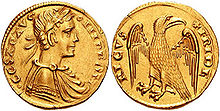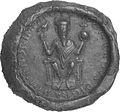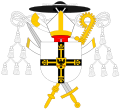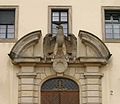Imperial eagle
The imperial eagle is the name of the eagle of those states that refer to an imperial idea through the eagle symbol and - indirectly or directly - tie in with the tradition of the Roman Empire or pursue this claim.
Throughout the Middle Ages , especially in the Holy Roman Empire , up to the 20th century, the eagle was the symbol for the imperial authority and command - inherited from Roman tradition . The Weimar Republic as well as the First Republic of Austria continued the imperial eagle as a republican emblem , in Austria since 1920 as the federal eagle , after the Second World War in the Federal Republic of Germany also as the federal eagle .
Origin and meaning: late Roman eagle


Like some other European Wappenadler derives the imperial eagle of the Roman ensigns , the aquilae decreases. In this line of tradition, he refers to the sovereign authority as such, the empire , and not to the person or the dynasty of the ruler, because the imperial Roman Caesars did not use the eagle as a personal or dynastic emblem. In addition, the double-headed eagle has been widespread in Asia Minor as a dynastic symbol since the 4th century. The late ruling families of Ostrom used the eagle and the double-headed eagle for this purpose. According to the pre-medieval Eastern Roman view, the eagle is therefore probably not a territorial symbol, but a symbol for a ruling family. According to medieval heraldic reading, however, the eagle primarily stands for a territory and the lordly authority over it. Following on from the iconography of the emperors of Ostroms, the eagle - first with one head, later generally two-headed - became the emblem of imperial dignity and position, of the empire throughout Europe ; identification with the dynasties themselves is less common and only appears again in the empire of Austria .
In addition to other ancient symbols, the Franconian Empire adopted the Roman eagle as a symbol of power in order to legitimize the Roman Empire and to represent the Franconian Empire as a linear continuation of the Roman Empire . This translatio imperii is expressed in the (not preserved) eagle on the Aachen palace of Charlemagne as well as in the Roman eagle on the ancient cameo , which was probably commissioned by Emperor Otto III around the year 1000 . was incorporated into the center of the Lothar cross . Due to its definition as a Carolingian national emblem , the imperial eagle falls within the context of the Carolingian Renaissance and its diverse endeavors to link in form and spirit to late antiquity and its Roman Empire. This tradition was later followed by the emperors of the Holy Roman Empire , in particular Otto III. whose corresponding endeavors are denoted by the expression Restauratio imperii .
Roman Aquila at the head of a standard in the seal of Castro Pretorio , the XVIII. Rione from Rome
Byzantine Empire , relief on the Church of St. George of the Ecumenical Patriarchate of Constantinople in Istanbul
Hauswappen the Palaeologi , the dynasty of the Byzantine Empire (1259-1453)
Imperial eagle of the Holy Roman Empire


The first heraldic representation of the imperial eagle can be found on a coin by Friedrich Barbarossa from the years 1172 to 1190, a few decades after the investiture controversy and just at the time when the emperor and his chancellery began to develop the concepts of the Honor Imperii and the Sacrum To introduce empire and thereby to re-emphasize the dignity, legitimacy and power of the empire and the realm in relation to the papacy, the nobility and the cities. The first color reproduction of the imperial eagle (black in a golden field) is historically tangible under Emperor Otto IV (1198–1218). The eagle appears in the seal of the imperial city of Kaiserswerth as early as 1270 - from there it gains its role as a royal-imperial emblem and heraldic animal on the imperial storm flag and imperial banner of the Holy Roman Empire , and thus a symbol of the Holy Roman Empire , in line with the state idea of the Renovatio imperii . In the case of Otto's successor Friedrich II in particular , imperial symbols, which, like the eagle, are linked to the insignia and iconography of the late antique emperors, were of great importance for conveying his idea of imperial and empire .
The double-headed eagle goes back to Emperor Sigismund and the year 1433 - in a transitional phase the single eagle symbolizes the Roman-German king , the double-headed the emperor . It also serves as a picture on the imperial banner and thus ties in with the tradition of the double-headed eagle east of the river, which is directed against the Islamic - Arab expansion .
Soon afterwards, as a quaternion eagle, it was covered with a selection of coats of arms of the imperial estates ( quaternions of the imperial constitution ) on the wings. This eagle carries the crucifix on its chest when it symbolizes the empire and the ruler's coat of arms when it symbolizes the Roman-German emperor.
The eagle was considered both an imperial symbol and a symbol of the empire. The use of an eagle was therefore always a commitment to the emperor and empire and was often awarded by the Roman-German emperors. Eagle coats of arms are typical of many free imperial cities that attached importance to their imperial immediacy and did not want to submit to any territorial lord , and can also be found in guild coats of arms and other things (see Other uses of the double-headed eagle ).
Third imperial seal of Conrad II with the depiction of a so-called eagle scepter, in use from 1029 to 1034
Depiction of the double-headed imperial eagle as the coat of arms of Otto IV.
Chronica Maiora by Matthew Paris , approx. 1250Emperor Heinrich VI. with the royal eagle coat of arms
Codex ManesseDepiction of the imperial eagle on coats of arms and naval flags of the imperial fleet of Frederick II in the naval battle of Giglio
Nuova Chronica by Giovanni Villani , early 14th centuryBlack, nimbly double-headed eagle in gold: imperial banner of the Holy Roman Empire (in use from 1400 to 1806)
Quaternion eagle , the wings with the imperial estates , as a symbol of the empire
Woodcut by Hans Burgkmair the Elder. Ä., 1510Imperial eagle on the west side of the choir hall of Aachen Cathedral
Double-headed eagle of the Holy Roman Empire on the coat of arms of the Gelderland city of Nijmegen
Imperial eagle as a one-headed eagle of German royalty on the coat of arms of the former imperial city of Aachen
Double-headed imperial eagle in gold on black in the coat of arms of the city of Vienna (1461–1925)
One-headed imperial eagle on the heart shield of the coat of arms of the Grand Master of the Teutonic Order
Imperial eagle on the coat of arms of the Imperial Abbey of Echternach and the city of Echternach
One-headed imperial eagle in the coat of arms of the former Oberhasli district and the municipality of Meiringen
Eagle of the Russian Empire
The tsarist Russia and later the Russian Empire took over with the imperial double eagle " the third Rome " from 1487. Whether it's a direct takeover or perhaps a marriage arms of Ivan III. is dealing with Sofia Palaiologa , or it was chosen through another route, is unclear. It can be found today in the national coat of arms of the Russian Federation .
Imperial eagle after the end of the Holy Roman Empire
After the end of the Holy Roman Empire in 1806, the eagle went up:
- the empire of the Habsburgs : the Austrian eagle , a double-headed eagle derived from the quaternion eagle with the coat of arms of the hereditary lands evidenced - even before the breakup from 1804 - for the empire of Austria , and from 1867 the Austro-Hungarian monarchy . Only here does a union of the imperial emblem with dynastic symbols and feudal property rights take place. Today's one-headed federal eagle of the Republic of Austria was deliberately introduced in 1919 at a distance from the monarchical imperial eagle; it is not derived from this, but from normal coat of arms eagles - while the nimbated double-headed eagle of the corporate state 1934–1938 again made an explicit reference to the Roman-German imperial eagle.
- the German Confederation : This confederation of states , founded in 1815, adopted the double-headed imperial eagle as a national emblem during the German Revolution in March 1848.
- the German Empire : Here the one-headed imperial eagle - based on the Prussian eagle - represented the emblem of the German Empire (1871–1918). From 1914 the German Empire planned to use the imperial eagle as a coat of arms element on colonial flags and the colonial coats of arms of German East Africa , German Cameroon , Togoland , German South West Africa , German Samoa and German New Guinea . The Weimar Republic (1919–1933) continued the imperial eagle as the form of government that followed the monarchy in Germany . On today's federal coat of arms of Germany and on numerous other symbols, marks of honor and emblems, the traditional line of the imperial eagle of the German Empire is continued under the name of the federal eagle .
Also for Napoleon I and Napoleon III. The Napoleonic eagle was the symbol of the armies in the assumption of the papal promised successor to the Roman Caesar power.
First empire under Napoleon Bonaparte
Coat of arms of the Austrian Empire from 1815 to 1915
German Imperial Eagle ( Empire ) from 1888
Double-headed imperial eagle on the coat of arms of the German Confederation from 1848
Imperial eagle of the Weimar Republic from 1928 and Federal eagle of the Federal Republic from 1950 ( Federal coat of arms of Germany )
Coat of arms of the Republic of Austria from 1945 and previously similar from 1919 to 1934
Imperial eagle in the time of National Socialism
During the time of National Socialism (1933–1945), the imperial eagle of the German Empire - with a completely different appearance than the imperial eagle - was usually depicted with the swastika in an oak wreath .
Imperial eagle and party eagle
The National Socialists took over the imperial eagle of the Weimar Republic in 1933 and modified it by adding their party symbol of the swastika and an oak wreath . The direction of the eagle's gaze determined the meaning:
- Eagle looking to the left (seen from the viewer) was the imperial eagle / state eagle / national coat of arms,
- Eagle looking to the right (as seen from the viewer) was the party eagle / party badge.
There are several theories about the "party eagle" designed by Hitler himself. Probably the most popular and most likely theory says that the party eagle represents the "back" of the imperial eagle. Symbolically, in the sense of a one-party system , the Führer principle and the totalitarian conception of the state of the Nazi regime, this would mean that there are two interdependent “halves”: the Reich and the party . Both united in the office of the " Führer ", who was both Reich Chancellor and party chairman , from 1934 also Reich President and thus head of state.
There were z. B. made small and larger statues of the imperial eagle with spread wings, which stood on a wreath with an engraved swastika. You can still see such eagles on buildings from this period. Only the swastika, which was a symbol of the NSDAP and its ethnic and anti-Semitic program, was chiseled out of the wreath in the course of the denazification of Germany.
Denazified imperial eagle with a chiseled swastika above the entrance to the Erlangen district court
Coat of arms of Prussia 1933–1935: eagle with sword and a lightning bundle borrowed from the Jupiter cult and the Napoleonic eagle , as well as a banner
Imperial eagle, compact form with attached wings, in a wreath of oak leaves ( de-Nazified with chiseled swastika, as a height mark on the Blaserturm in Ravensburg )
Reichsadler on the Deutsche Reichsbahn locomotive E 19 12
Imperial eagle above the main entrance of the Dobl transmitter , Styria
Denazified imperial eagle with the coat of arms of Schleswig-Holstein and Flensburg under the wings, at the marine sports school in Flensburg-Mürwik , where the last imperial government was arrested in May 1945 .
Web links
- Peter Diem: The development of the Austrian double-headed eagle. In: Vexillology Austria. Retrieved May 18, 2009 .
Individual evidence
- ↑ Norbert Weyss: The double-headed eagle - history of a symbol. In: Adler Heft 3, 1986, p. 78 ff.
- ↑ a b Weblinks: Diem, development of the double-headed eagle
- ↑ Diem, Doppeladler , section "The Byzantine Relatives"
- ^ Franz Gall: On the development of the double eagle on the imperial seals. In: Adler , Volume 8, Issue 16/17, 1970, pp. 281 ff.
- ↑ E. Kamentseva ( Moscow State Institute of History and Archives ); N. Soboleva ( Russian Academy of Sciences , Institute of History); quoted after Vladimir Monakhov: New old color of Russia, or return of the eagle . Ed .: ГЕРАЛЬДИКА СЕГОДНЯ. February 1, 2003 ( Online [accessed September 17, 2008] Russian: Новые-старые цвета России, или Как возвращали орла .).
- ↑ Diem, Doppeladler , section "The Importance for Austria"


































